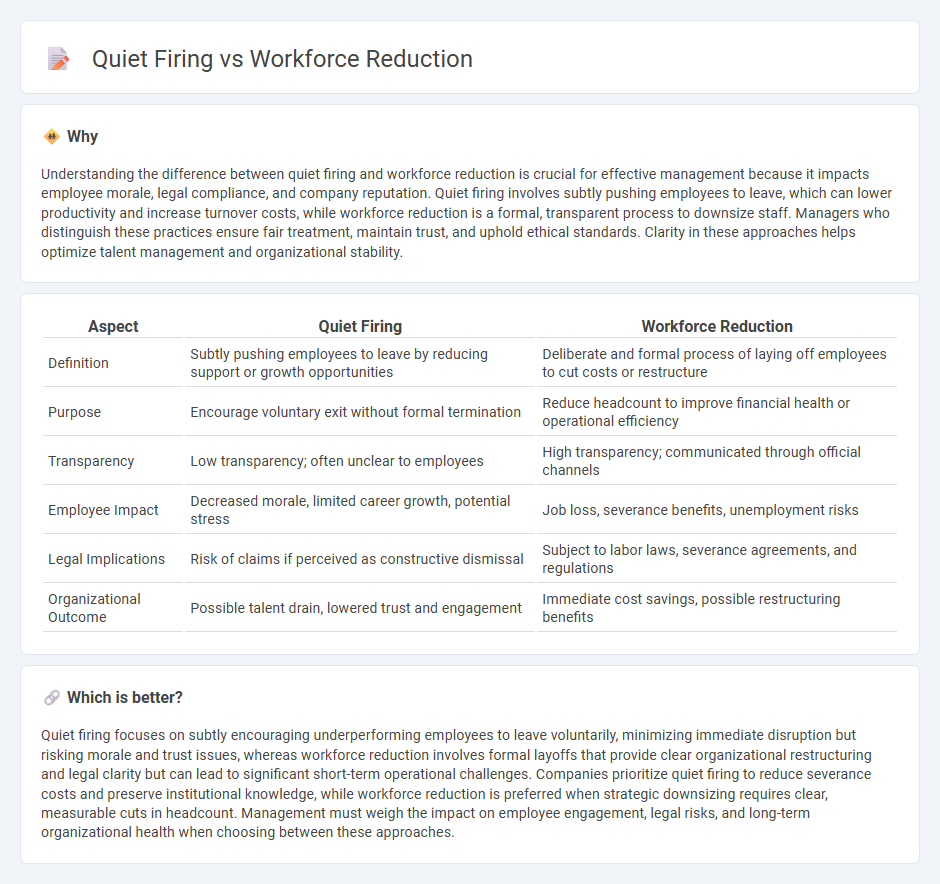
Quiet firing refers to the subtle, often unspoken strategy where employees are gradually pushed out through diminished responsibilities or lack of support, contrasting sharply with workforce reduction, which involves clear, formal layoffs or terminations due to business needs. Companies adopt quiet firing to minimize immediate disruptions, while workforce reduction typically addresses larger organizational restructuring or economic pressures. Explore the nuances and implications of these distinct management approaches to better understand their impact on corporate culture and employee morale.
Why it is important
Understanding the difference between quiet firing and workforce reduction is crucial for effective management because it impacts employee morale, legal compliance, and company reputation. Quiet firing involves subtly pushing employees to leave, which can lower productivity and increase turnover costs, while workforce reduction is a formal, transparent process to downsize staff. Managers who distinguish these practices ensure fair treatment, maintain trust, and uphold ethical standards. Clarity in these approaches helps optimize talent management and organizational stability.
Comparison Table
| Aspect | Quiet Firing | Workforce Reduction |
|---|---|---|
| Definition | Subtly pushing employees to leave by reducing support or growth opportunities | Deliberate and formal process of laying off employees to cut costs or restructure |
| Purpose | Encourage voluntary exit without formal termination | Reduce headcount to improve financial health or operational efficiency |
| Transparency | Low transparency; often unclear to employees | High transparency; communicated through official channels |
| Employee Impact | Decreased morale, limited career growth, potential stress | Job loss, severance benefits, unemployment risks |
| Legal Implications | Risk of claims if perceived as constructive dismissal | Subject to labor laws, severance agreements, and regulations |
| Organizational Outcome | Possible talent drain, lowered trust and engagement | Immediate cost savings, possible restructuring benefits |
Which is better?
Quiet firing focuses on subtly encouraging underperforming employees to leave voluntarily, minimizing immediate disruption but risking morale and trust issues, whereas workforce reduction involves formal layoffs that provide clear organizational restructuring and legal clarity but can lead to significant short-term operational challenges. Companies prioritize quiet firing to reduce severance costs and preserve institutional knowledge, while workforce reduction is preferred when strategic downsizing requires clear, measurable cuts in headcount. Management must weigh the impact on employee engagement, legal risks, and long-term organizational health when choosing between these approaches.
Connection
Quiet firing and workforce reduction are connected through their impact on employee engagement and organizational efficiency. Quiet firing, characterized by subtle measures to encourage employees to leave voluntarily, often precedes formal workforce reduction by reducing morale and productivity. Both practices aim to optimize labor costs while minimizing public scrutiny and disruption within the company.
Key Terms
Layoff
Workforce reduction and quiet firing both impact employee retention but differ in execution; layoffs involve formal termination processes driven by organizational restructuring, while quiet firing subtly pressures employees to leave without official dismissal. Layoffs often result from financial constraints or strategic shifts, affecting a broad employee base with severance packages and official notices. Explore how companies navigate these approaches and their effects on workforce morale and legal considerations.
Performance management
Workforce reduction involves formal layoffs or terminations often driven by economic or strategic factors, whereas quiet firing refers to subtly pushing underperforming employees out through reduced opportunities and lack of support. Effective performance management sharpens clarity around expectations, provides structured feedback, and mitigates risks of disengagement or legal challenges associated with quiet firing tactics. Discover more about aligning performance management strategies with ethical workforce practices for sustainable organizational health.
Employee disengagement
Workforce reduction involves officially terminating employees to cut costs or restructure, often leading to decreased morale and increased disengagement among remaining staff. Quiet firing, a subtle form of employee disengagement, occurs when employers intentionally limit opportunities, ignore contributions, or withhold feedback to push employees toward voluntary exit without formal dismissal. Explore further to understand how these approaches impact workplace culture and employee productivity.
Source and External Links
What Is Workplace Reduction? - Workplace reduction, also known as downsizing or rightsizing, involves reducing a company's workforce or physical workspace through a structured process.
How to Handle a Workforce Reduction - This resource provides strategies and steps for managing workforce reductions effectively, including using data analytics for decision-making.
Agencies to 'Redouble' Efforts to Rightsize Their Workforces - Federal agencies are renewing efforts to reduce their workforces after a Supreme Court ruling lifted an injunction blocking such actions.
 dowidth.com
dowidth.com